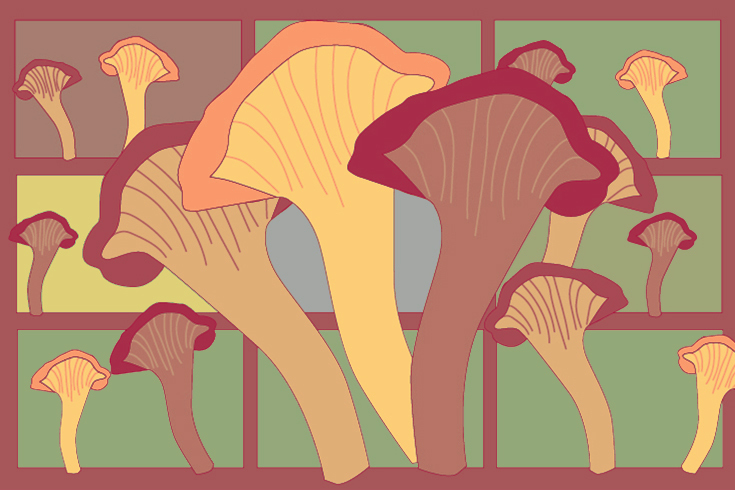It’s a windy mid-June day as Lori McCarthy walks a beach near the town of Colliers, in Conception Bay, Newfoundland, hunting for something to eat. Her trademark long amber braid hangs over one shoulder, and she carries a belt knife with a walnut handle and a canvas crossbody satchel to hold what she finds.
Around 2,000 kilometres away, I watch via a Zoom video call as McCarthy, a chef originally from Bauline, Newfoundland, takes me on a virtual seaside foraging trip. With me is a copy of Edible and Medicinal Plants of Canada so I can try to follow along. She points her phone’s camera at the mouth of a river that empties into the bay, a popular salmon-fishing spot, and tells me how the younger generation seems to prefer hook-and-release. “I’m not a fan of it,” she says. “If I’m going to take it, I’m only going to take it if I can eat it. That’s my own kind of philosophy.”
McCarthy runs Cod Sounds, a culinary-excursion company that offers field workshops on traditional Newfoundland cuisine and sourcing wild food. Her workshops range from a beach stroll identifying wild edibles followed by an open-fire foraged-seafood meal to tutorials on making seaweed salt and cloudberry jam or even preserving moose in glass jars (a Newfoundland specialty). In her On the Hunt workshop, participants spend a winter morning setting snares, tracking, and field dressing wild game before cooking the hares over a fire and “discussing techniques, sharing stories and passing on a way of life.” But, when the pandemic hit and travel restrictions clamped down on movement, McCarthy’s business, like everything else, was forced to adapt.
Before she became a chef, McCarthy worked in adventure tourism as a kayak and hiking guide. Then, one day, she walked into a popular St. John’s restaurant for a kitchen job and mentioned that she knew how to bake bread from watching her mother and nan. She ran her own personal chef business for a while before taking five years off to have her two children—a time she also used to get outdoors and learn about wild foods. By the time she reemerged onto the Newfoundland culinary scene, gathering wild food had become a major international trend. Modern foraging, she realized, was a new way of looking at the local landscape, something that could become a tourism attraction for foodies but also act as an educational tool.
McCarthy named her company Cod Sounds after the fish’s air bladder, a part that had no market value, so locals learned to cook and eat it along with other fish offal. It is a fitting name, a nod to the fact that culinary creativity and great food can be found in unusual places, if you care to look.
When McCarthy was little, every year, at the end of August, she and her younger brothers would join their mother, nan, cousins, and aunts on the berry grounds. Having grown up in rural Newfoundland, about half an hour’s drive from St. John’s, McCarthy says wild blueberry picking season was serious business. There were also bakeapples, in July, and cranberries and partridge berries, in October—the last opportunity to gather fresh fruit before the long winter.
The gaggle of pickers would head out every nice day for weeks, spending six or eight hours on the berry grounds at a time. McCarthy’s family would set up camp, make a fire, and cook traditional foods, like homemade buns with a bit of fresh berry jam, smoked mackerel and fish cakes, and always plenty of tea. “That’s where the love of that kind of food comes from,” says McCarthy. “I’m trying to hold on to that nostalgia.” But keeping these skills alive is more than just nostalgia.
Newfoundlanders are no strangers to scarcity. Throughout the difficult years in the early 1990s, after the cod moratorium shut down the island’s fisheries, and despite the subsequent decades-long economic see-saw, Newfoundlanders found ways to endure. Little grows on the island for eight months of the year, and Newfoundland has historically been more vulnerable to extreme weather and delivery disruptions than many other parts of Canada. “When mom was growing up, everything was about harvest, collect, gather, hunt, preserve, dry, salt,” McCarthy says. “Just two generations ago . . . we were almost completely self-sufficient outside of flour, molasses, and sugar.”
At its core, Cod Sounds is about preserving a culture of resilience and ingenuity along with the skills and knowledge learned by multiple generations spanning many harsh winters. McCarthy has turned her knowledge of old food ways, much of it passed down from her mother and nan, into a way of life that both reveres the past and safeguards the future. She doesn’t want Newfoundlanders to forget what they learned during the hard times.
Whenever she travels around the island, McCarthy calls ahead to communities and asks if there are any older folks who would be willing to have a cup of tea with her. Over the span of a decade, she has gathered hundreds of stories, recordings, and recipes from sitting in strangers’ kitchens and talking about what they had to do in tougher times to survive the harsh climate. “I learned that we’re not as poor off as I thought we were,” she says. “The older generation was way better fed, was way better prepared for anything than we are today.”
I began looking into Cod Sounds workshops just before the pandemic made travel impossible. I had my eye on the March hunting workshop: the ability to snare a rabbit seemed like it might come in handy someday. Instead, by the second week of April, my partner and I found ourselves living at my parents’ Ontario cottage, coming to terms with our thwarted plans. Like everyone else I know, I felt unmoored and unfocused. And, like many during this time, I turned to the simpler things. Over the next few weeks, we planted a vegetable garden, my partner made paddles out of discarded wood, and I bought a pottery wheel.
Throughout the various lockdown experiences, for many, was a sudden desire to retreat inward, toward family and place, to reconsider what is important—and to bake some bread. In April, as people were forced to spend more time inside, Google Trends reported an all-time high on queries about baking. Around the same time, grocery stores across North America were experiencing shortages of yeast. Extra hours at home and fear of food shortages may have been to blame, but as Katharine Gammon wrote in the Guardian around that time, “Rolling, kneading and mixing all have a calming quality, forcing you to be in the moment and not stuck mentally in the future or past.” Naturally, it seemed, people turned to working with their hands and doing something that has been done for generations as a way to manage uncertain emotions.
“It’s what chicken soup is on a day when you’re not feeling well,” says Bill Swan, an expert in sustainable food systems and cofounder of adventure-tourism company Adventure Canada, with which McCarthy has worked as a cultural food “ambassador.” “These are comfort actions on a societal level.” By the time of our conversation, in mid-August, Swan had already received three calls that week requesting his consulting services on designing community greenhouses. Over a decade ago, he was project lead (and later executive director) of the Groundswell Networks Society and helped build a 3,000-square-foot community greenhouse in Invermere, British Columbia, with a mandate to strengthen people and communities through food. Swan is watching the coronavirus—which he calls “the Great Revealer”—bring these values back to the fore and expose the cracks and sore spots in the current system.
When I first spoke with McCarthy, in April, she also told me she was in high demand. People were reaching out, asking her how to bake bread and where to get eggs (or even hens). CBC Newfoundland featured her in a three-part back-to-basics series. “We have really gone quickly back to an old way,” she says. “People are scrambling to set gardens and get animals, and it’s more my generation who are trying to figure all this stuff out.” The day before, a young woman had come to pick up ashes from McCarthy’s wood stove because she wanted to make soap.
At the start of the pandemic, the shortages of flour and yeast on the island were especially dire. “You can’t buy yeast in Newfoundland anymore,” McCarthy said at the time, because so many people have gone back to making homemade bread. By the beginning of May, her workshops had migrated online, to hour-long webinars, and in response to the island-wide yeast deficiency, she announced she would demonstrate in her upcoming Spring Edibles workshop how to cultivate wild yeast. Those around her found it unusual—growing yeast from foraged goods is not a typical practice in Newfoundland, she says—but it was one of many new things McCarthy has experimented with since she first began extensively foraging, about ten years ago. Her Instagram account, which attracts both curious beginners and fans seeking advice and sharing their experiences, shows many jars of gooey wild yeast that she has collected: one from juniper berry, one from blackcurrant, and one from wild mushroom powder.
The webinar sold out in less than forty-eight hours, and on May 29, forty people from around Canada and the United States tuned in via Zoom, McCarthy recalls. Anyone wanting to make a wild-yeast starter would need half a cup of wild berries or dehydrated mushrooms (preferably foraged: store-bought mushrooms may have been exposed to pesticides), half a cup of nonchlorinated water, and a one-litre jar. My own jar of yeast, which I had cultivated, at her direction, using rhubarb from our garden, never made it past infancy, but whether her students are successful or not, McCarthy encourages the adventure of discovering new foods and makes everyone feel like they are part of a community.
On that June day, McCarthy’s pixelated image glitches momentarily as she stoops to examine a plant, followed by an awkward forty seconds of her speaking without any sound. We are just getting started, but it’s clear my personalized foraging experience is a far cry from a workshop—we’re not walking side by side on the beach, and we won’t sit around an open fire learning about different salting and preserving techniques. I won’t taste Labrador Arctic char, mussels, or salted mackerel, and McCarthy won’t have the time to share stories of how her nan, at the age of nine, would make bread each morning for her twelve siblings. Instead, McCarthy covers some foraging basics: pick only what you expect to use and never forage near beaches or rivers whose waters feed out of contaminated zones. “The beauty now is that you can just open up Google Maps and track a river for as long as you want,” she says. She also tells her guests to first find the Latin name of a plant they want to pick so they can look it up on the internet. Once it’s positively identified, then it’s just a matter of knowing what to do with it.
Traditionally, the island’s older generations would collect dandelions in the spring, followed by partridge berries, bakeapples, and blueberries before the snows came. Foraging, McCarthy says, is deeply ingrained in Newfoundland culture, but modern knowledge has expanded the breadth of species available to the picker.
The camera focuses on five tiny green spiky leaves sprouting up through the sand and pebbles. It’s known as sea rocket, but McCarthy likes to call it her wasabi due to the plant’s spice. She usually grinds it into a paste with a mortar and pestle, adding salt and water to create a pesto-like consistency. Preserved this way, the sea rocket will keep well in the fridge. Together, we identify wild roses (the petals can be ground with sugar to make rose sugar) and daisies (the leaves can be used in salads, the petals are edible, and the yellow buds can be picked and eaten like capers). We find sea sandwort, an herb my reference book says is rich in vitamins A and C and nutritionally valuable to Inuit but also “makes an attractive patch to sit or spread your towel on.”
As we make our way across the beach, it’s evident that McCarthy judges every living thing in her path as edible, not edible, or edible but only the one time. (Some things just don’t taste very good or can make you ill.) She expanded her knowledge and foraging skills by reading, watching documentaries, speaking with Indigenous people, and a lot of trial and error. She supplies the foraged goods she finds to the culinary scene of St. John’s, including Raymond’s, an upscale restaurant that prides itself on local wild food (and where a seven-course meal is $255 with a wine pairing). As many restaurants struggled to survive the cancelled tourist season this summer, McCarthy focused her energy on bringing wild food to the people of Newfoundland through her now-online seminars. She admits that, for most individuals, foraging will likely reach only a hobby level, but the connection to place and old ways can broaden one’s perspective. “If it makes you think a little bit more about your food and where it comes from, the plants that grow underneath your feet,” she says, “I think that alone will make enough of a difference.”
What McCarthy pointed out many times throughout our conversations, which spanned from April to the end of August, is that the values she is trying to pass on to others—connection to place, community, creativity, resilience—are needed now more than ever. “I’m excited by the possibility that we could come out the other side of this rediscovering the things that we hopefully only temporarily lost in terms of values and skill sets,” says Swan, who attended McCarthy’s June online workshop on mushrooms with his daughter Shannon.
Around a month after COVID-19 was declared a pandemic, The Atlantic published an article titled “After Social Distancing, a Strange Purgatory Awaits.” The writer, Juliette Kayyem, pictured our collective emergence from stay-at-home orders as a long-term lesson on living with the virus, or what she dubs “adaptive recovery.” Separated from friends and our old routines, we’ll need the skills and values picked up during isolation as acts of self-care and resilience on the long road ahead. Maybe we won’t stockpile homemade loaves of bread come December, but the commitment made to yeast starters in the spring will be there when we need it.
At the end of August, McCarthy and I connect for the last time, over Zoom, while she shepherds her two kids, Daniel, eight, and Maria, ten, around a local forest. They are on the hunt for mushrooms. The group forages chanterelles and hedgehog mushrooms, also known as sweet tooth. McCarthy points the camera at a small yellow mushroom, a variety of Amanita muscaria that is not supposed to be eaten, and notes that its white and red counterpart was the inspiration for the mushrooms that appear in Super Mario Bros. In a couple of weeks, it will be blueberry season, and McCarthy, her mother, her nan, and the kids will go back to the berry grounds, if even just for the sake of tradition.
I ask McCarthy a question that has been simmering all summer: Why forage for wild food, hunt, preserve, and salt if you don’t have to? Her answer, in the end, is because you can and you never know. “We’re not in hard times here anymore, but the fact that people have this desire to go back to the land and learn from the other generations, to me that’s the real treasure in it.” A few days before, ferry strikes had been announced, a worry for many Newfoundland communities, where food deliveries are crucial. McCarthy has a freezer full of wild foods—turrs, ducks, geese, and cod, plus foraged goods—that would last her six months, so she feels prepared. And, if not, she will be able to find sustenance between the island’s rocks.




